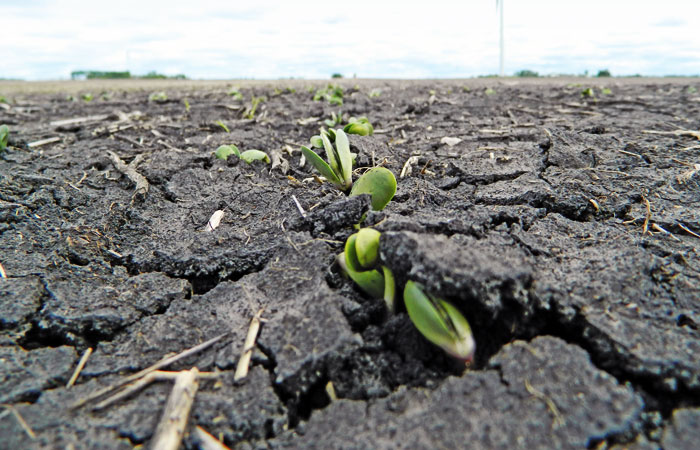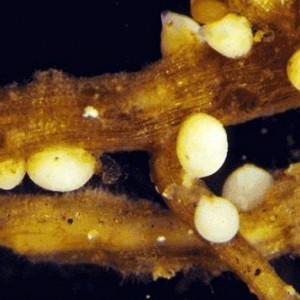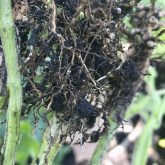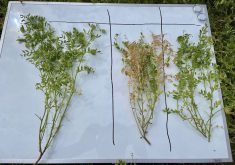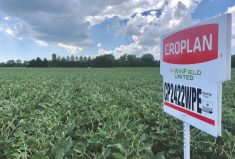It’s an in-field whodunnit — a burgeoning crop disease that closely resembles other better-known problems, but is its own unique culprit, with its own unique symptoms, development and costs.
The first symptoms are a widespread mottling and crinkling of leaves on soybean plants, usually coming after the start of flowering, though in rare cases symptoms can be found on younger plants. Later, leaf tissue between the major veins turns yellow, then ultimately dies and turns brown.
To the farmer observing this in the field, it could be the foliar symptoms of any number of plant diseases. Perhaps brown stem rot, stem canker, charcoal rot or even chemical burn from crop protection applications. But as the season progresses, it becomes apparent this is a whole new problem.
Read Also

Could crop sharing be a viable option for your farm?
Crop sharing could be a good option for young and beginning farmers.
Soon after, the tender young leaflets begin to die and shrivel and in the most severe cases the leaflets will drop off, leaving only the plant’s petioles attached.
Going in for a closer look, a field scout or farmer will pull a few affected plants. What they’ll find are stunted root systems lacking vigour when compared to a healthy root system. In some cases the roots may also be rotted. If the plants are collected from moist soil, small light-blue patches may be visible on the surface of the taproot, near the soil line.
It’s these patches that give the best hint as to what the problem might be, distinguishing it from a plethora of other potential sources. To finalize the diagnosis, the lower stem and taproot must be split. In a healthy plant the cortical tissue will be white, but in this case the same tissue will show tan or light brown streaks.
What ails the crop is a disease common to other soybean-growing areas and on the rise in Ontario — sudden death syndrome, or SDS. It’s caused by the pathogen Fusarium viguliforme, which will be familiar to growers for its role in the damping-off complex, but also is the source of this growing new plant disease with its own threat to plant health.
It’s a growing concern for producers because it’s a problem that’s been increasing in scope in recent years, says OMAFRA field crop pathologist Albert Tenuta. He says 2013 provided an almost perfect setting for this disease to flourish. Ideal conditions for SDS include a cool wet start to spring, followed by normal temperatures and normal rain patterns towards the middle of the season. Heavy rain events that followed later into the season and saturated the soil for a few days only worsened the risk.
“Everything we had last year worked perfectly for SDS, and if you throw in a heavy rain or a flooding situation, where the soil is saturated for a day or two into late July and early August, again, those are conditions that seem to spur further development,” says Tenuta. “SDS is different from many other soil-borne diseases or root rots in that it colonizes very early in the season, usually within the first two, three or four weeks of emergence or seed development. And it sits there for a while, growing into the root system, and then that development often corresponds with the cooler weather conditions, and that again is good for the disease development in the root system.”
When temperatures rise into the 21- to 32-degree range in mid summer, growers will see foliar symptoms start to appear. Tenuta adds that SDS is unique in that the disease symptoms on the leaves are not the result of the pathogen or the disease organism migrating up to the leaf, but because of the damage inflicted in the root system where the disease is colonizing the root tissue. That colonization results in a toxin which moves up into the plant, creating visual symptoms on the leaf.
On its own, SDS has the capacity to cause yield losses of 10 per cent under normal weather conditions. But another development that’s causing concern for some growers is the advance of soybean cyst nematode (SCN) into areas of the province where it’s not been an issue (see related article at bottom). SDS when combined with SCN can more than double that potential yield loss.
- More Country Guide: Global demand rekindling interest in IP soybeans
What to do
It’s worth noting that in January 2008, Tenuta was cited in a farm publication for his unique perspective on the news that SCN had been confirmed in fields east of Toronto — a discovery which he counterintuitively deemed “a good-news story” because it’s manageable, as are most of the pest, disease and weed challenges facing growers. SDS is following the same lead, Tenuta said, and the good news is that there are management tools that can reduce the risk of SDS in soybean fields. Good plant genetics are the key with most disease management programs and Tenuta advocates planting disease-tolerant or SDS-tolerant varieties.
“There are some tolerant varieties in the marketplace — not a lot, but there are a number of them in the different maturity groups and most companies have some,” says Tenuta, adding that no single variety is completely immune to sudden death syndrome. “In terms of seed treatment, yes, the general seed treatments work on a broad spectrum against many of the different fusariums, and SDS might be one of those where we may not get the level of control that we’d like, hence we’re looking at some new seed treatments that are in the research pipeline right now that look very promising, and look very good for SDS management.”
Tenuta adds that these treatments are not complete solutions and they won’t eliminate the disease. What they will do is delay infection as well as symptom development by weeks, allowing the plant to continue to develop and grow, and minimize the impact of the root injury as well as toxin production.
“And because the cool wet conditions early on in the season are favourable for sudden death syndrome, one of the recommendations is to alleviate the compaction or increase the water movement in the soil,” says Tenuta, adding that step can be accomplished through tile drainage, or, depending on the grower’s management practices, tillage.
“Anything that can alleviate compaction and increase water movement in the soil will help,” Tenuta says.
Far from advocating tillage as “the only option,” Tenuta counters that it’s something that can be incorporated into a grower’s program. As for those in no till or other soil conservation programs, there’s the option of delaying the disease with a delay in planting date. Planting later in the spring, when soil temperatures tend to be warmer and conditions are drier, allows the plant to develop and the roots to grow rapidly, minimizing the potential for the SDS pathogen to infect the plant.
Although it’s an effective strategy to delay development of the disease, it also runs contrary to the current practice of planting early to maximize a variety’s full maturity. As seed treatments have enhanced that capability for early planting, farmers have pushed the limits on maturity levels, and delaying planting —even to delay the onset of SDS — may not fit with growers’ aspirations. Yet that’s only half of the disease story. There is also a higher level of inoculum in fields across Ontario.
“We’re seeing more and more of the Fusarium around in the area, particularly as we’ve seen an increase in soybean cyst nematode,” says Tenuta. “Soybean cyst nematode and SDS are closely associated and, in many cases, the nematode’s cysts that are produced are colonized by the SDS fusarium, and by moving SCN development, you’re increasing or transporting or vectoring the SDS, as well.”
Again, that’s the good-news aspect with managing the disease, adds Tenuta. It isn’t just one method of unsettling the disease pathogen or the colonization effects. There are multiple strategies that can be employed. If early planting is a preferred practice, then perhaps some form of tillage is an option. If tillage is to be avoided, then plant genetics is yet another choice.
SDS and SCN — a disturbing trend in soybeans
Late last fall, it was reported that soybean cyst nematode, long viewed as the chief disease threat to soybean growers in Ontario, was on the move once again. In 2008, its discovery in the Belleville area was greeted by most as an indication that growers in the province were losing the war against this disease. It was firmly entrenched throughout southwestern Ontario, and had moved through Middlesex and Oxford into Niagara and farther east. The announcement last fall revealed that SCN is now moving northward into midwestern Ontario regions.
For Albert Tenuta, field crops pathologist with the Ontario Ministry of Agriculture and Food, there is little reason for surprise at that revelation. In fact, the migration of SCN into north Wellington and Perth counties is expected, yet it is unwelcome for another reason: SCN and sudden death syndrome are becoming a serious “one-two punch” to soybean yields.
“We are seeing soybean cyst nematode branch further north, as well as east, and then most recently this past summer into Quebec,” says Tenuta, adding that it’s been found in Huron and Bruce counties as well. “But we expect that based on how the disease has moved in the past in other locations. Basically, wherever soybeans are grown, soybean cyst nematode manages to make its way there. That’s an unfortunate reality, but we are in a good position in many of those locations, because there’s increased awareness by producers, by companies and private breeders in terms of the development of how earlier-season SCN-resistant varieties are progressing.”
The bottom line is that management tools are there, and timely effective use of these tools should result in less of an impact for many of those producers in these new areas. Above all, says Tenuta, it should increase the awareness of the disease but it’s not something that should be feared as it was when it was first detected in southwestern Ontario.
But what is also creating concern is the combined effect of SDS and SCN. On its own, SDS can be very problematic, says Tenuta. The cool, wet conditions early in spring, followed by warmer temperatures, then frequent wet-dry cycles throughout the latter stages of the season — those are the perfect conditions for SDS infection, leading to colonization of the roots and ultimately the above-ground symptoms and yield loss.
“When you have soybean cyst nematode in the mix, it substantially increases the amount of SDS injury we see, as well as yield loss,” says Tenuta. “So there’s a synergistic impact as well, when the two of them are together, SDS increases considerably under good or average moisture conditions. Under dry conditions, even with or without SCN, it’s not as noticeable because the dry conditions aren’t very good for the SDS. But dry conditions on their own are very good for soybean cyst nematode. So under those conditions we may see less of SDS but we’ll often see an increase in soybean cyst nematode injury.”
Under normal weather conditions, SDS can cost growers 10 per cent of their yield. Add in SCN, it’s closer to 40 per cent. Under drier conditions, yield losses might be limited to 10 to 15 per cent for both of them.


